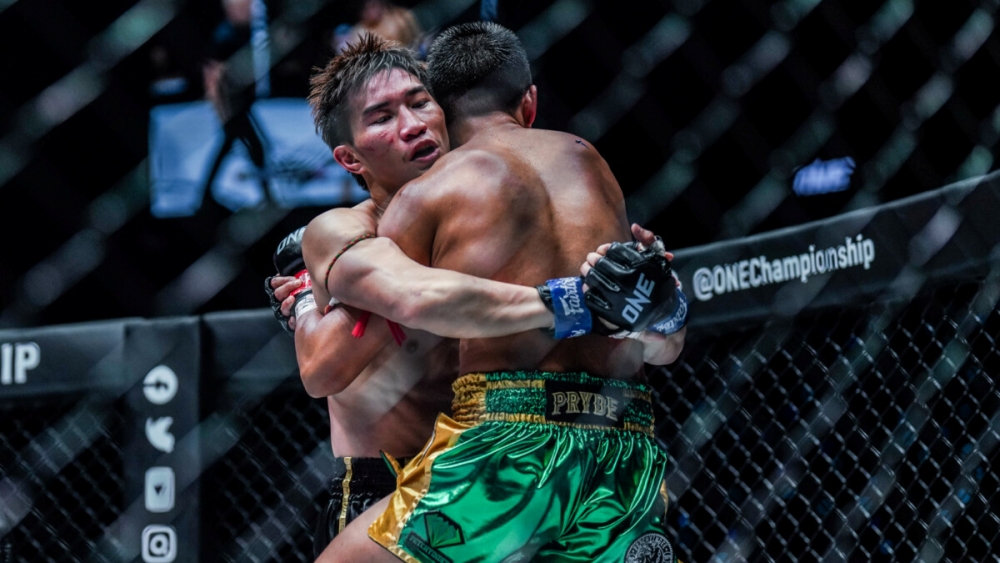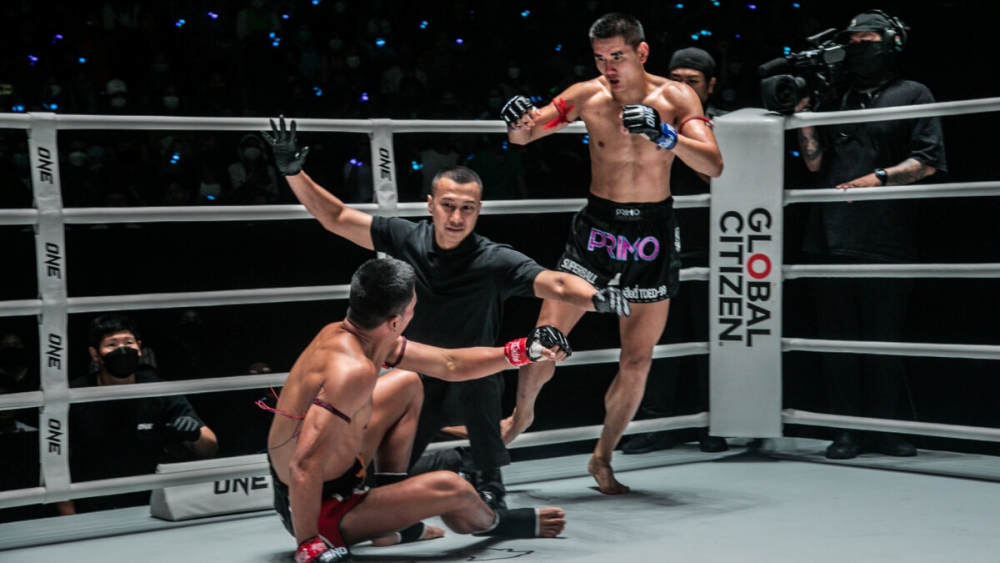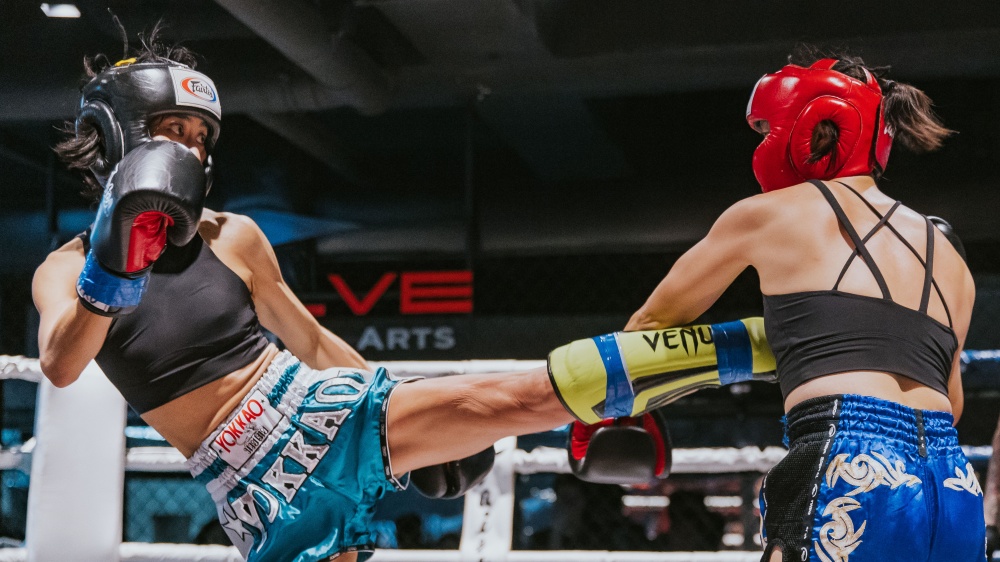Muay Thai, known as the art of 8 limbs is a savage sport. Knockouts, cuts, and broken bones are common outcomes when two fighters clash in the ring. With savage techniques such as elbows and knees to the head allowed in professional contests, many new fans are surprised to find that there are actually several rules in place to protect a fighter’s health and safety.
In this article, we reveal 8 common Muay Thai fouls. We’ll explain what they are and why these techniques are against the rules, and we’ll give a few examples of how to avoid committing them when you are in the ring.
1) Kneeing To The Groin Area
This one goes without saying. Anyone who’s been hit square in the groin during a fight will tell you that the pain lingers, affecting the way that they fight for several minutes after the offending strike. If you accidentally knee your opponent in the groin during a contest you will be given an immediate warning, and the referee will allow them up to 5 minutes to recover before resuming action. If they cannot recover after that time, the fight will be called off and deemed a “No contest,” so you want to be careful with your knees.
There is considerable debate online over whether or not teeps directly to the groin are legal in traditional Muay Thai. Though there is a considerable argument that foul strikes are strictly considered to be knees to the groin while in the clinch and therefore teeps to the groin are ok, it is widely considered that any intentional groin strike is purely bad sportsmanship.
In fact, Rajadamnern Stadium states the following on their website in no uncertain terms:
“Deliberate strikes to the groin area are off-limits due to the high risk of serious injury.”
So, simply put, no strikes to the groin. Ever.
2) Hooking The Leg
Sweeps and throws are a huge part of Muay Thai and are among the sport’s highest-scoring techniques. Catching an opponent’s kick and then sweeping out their supporting leg can send them crashing headfirst into the canvas. It can knock the wind out of them and affect their confidence, causing them to throw fewer kicks.
When sweeping and throwing in a fight, you can use your hip and the front of your shin to volley your opponent skyward. However, you can’t hook your opponent’s standing leg with your own to sweep them. Simply put, you can’t use the back of your foot or have your calf muscle in contact with your opponent’s leg to send them crashing down. Doing so would be considered a trip and not only does it not score, but it is also seen as poor technique.
3) “Judo” Throws
There are a number of sweeps and throws that you can utilize from the Muay Thai clinch. Controlling your opponent’s balance and posture, causing them to lose balance and fall to the floor is one of the highest scoring techniques. However, there is one illegal throw that is commonly seen in amateur contests and it looks something like in the video above.
This throw uses the back of your leg to break your opponent’s posture. Which, as we’ve already noted, is a foul. Also, turning your back on an opponent in the clinch shows that they are overwhelmingly dominant. It looks like you are retreating which puts you in a position where you cannot defend yourself, so not only does this throw not score, but doing so can also have a negative effect on you on the scorecards.
4) Grabbing The Rope
In Muay Thai, there are many ways you can use the ropes to your advantage. Unfortunately, grabbing them with your glove is not one of them. While you can lean onto or over the ropes or position yourself against them at your behest in a fight, grabbing them insinuates that you have lost control and that you would have been swept or fallen if they were not within reach.
Your opponent may sweep you into the ropes, causing you to maintain a standing position. This isn’t a problem; it may score slightly in the eyes of the judges but not as much as a complete sweep as it was not effectively executed. Grabbing the ropes implies that you have cheated your opponent out of a scoring sweep. So, if you get swept into the ropes you may lean against them, just don’t use your hands.
5) Striking A Downed Opponent
In Muay Thai, a downed fighter is someone who has anything other than the soles of their feet on the ground. You cannot strike a fighter who is on their back, has taken a knee, or has placed their glove on the canvas. This means that you cannot follow your opponent to the ground during a sweep and “accidentally” drop a knee or elbow on them in the process. (Following your opponent to the ground in a sweep also shows a lack of control and does not score as highly.)
However, you can strike an opponent as they fall. You just need to make sure that your timing is on point because if you accidentally commit a foul and your opponent is unable to continue, the fight will be ruled a “No contest”.
6) Taking More Than Two Steps After Catching A Kick
This is one of the most common fouls committed in Muay Thai and one that is also most commonly misapplied in contests. Many people incorrectly believe that you are only allowed to take two steps after catching an opponent’s leg before you need to sweep them or drop their leg. In fact, the rule is a little more nuanced than that. The two-step rule applies only to forward steps, meaning that you can take as many backward steps as you’d like whilst holding your opponent’s leg without committing a foul. Also, if you are a stickler to the rules, you can only take a maximum of two steps before you need to use a Muay Thai weapon. That means if you take two steps and then pull your opponent into a knee, the count restarts and you are allowed to take a further two steps.
This rule has only been applied in recent years. In the past, you could catch a kick and “plough” your opponent across the ring so that they bounce heavily off of the ropes and into your incoming attack. This often resulted in fighters getting thrown clear over the ropes and out of the ring, leading to some pretty serious injuries.
7) “Breaking The Spine”
A common foul from the Muay Thai clinch involves “breaking the spine” to perform a throw from the body-lock position. This foul is performed when a fighter squeezes their opponent’s spine, driving them backward in an almost bearhug type of movement. This is incredibly dangerous as it can cause permanent spinal injuries that a fighter will carry for the rest of their life. So, if you end up in a body-lock position make sure that you turn your opponent, using your hips to take them down.
8) Striking The Back Of The Head And Targeting The Spine
Muay Thai may be vicious, but at the end of the day it is still a sport and though every fighter who climbs over the ropes does so at the risk of some pretty serious injuries, it is never anyone’s goal to inflict debilitating and life-altering injuries on their opponent. Therefore, this final foul should be pretty self-explanatory.
Hitting the back of someone’s head or their spine can cause permanent damage to their nervous system. We’re talking about brain damage and paralysis here, so no matter how close or heated a contest is, never target them under any circumstances.
Generally, you can only hit these areas if your opponent has their back to you. If this is the case, you are already in an extremely dominant and high-scoring position and the referee will no doubt be moments away from intervening to warn your opponent or to put a count on them, so take the points you’ve already been awarded and let them live to fight another day.
You may also like:




















